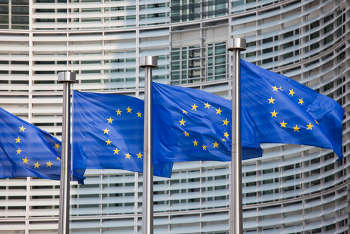Cities and local authorities, as well as new technology, are crucial for the delivery of a new European strategy for low-emission mobility, the European Commission (EC) has said.
The strategy sits alongside proposals for binding national emissions targets under the European Union’s (EU) 2014 commitment to reduce greenhouse gas emissions by at least 40% by 2030 (compared to 1990 levels) across all sectors of the economy.

European flags in front of the headquarters of the European Commission
The EC said the strategy sets ‘clear and fair guiding principles’ to member states to ensure Europe stays competitive and will be able to respond to the increasing mobility needs of people and goods.
EU commissioner for transport Violeta Bulc said: ‘Transport accounts for a quarter of Europe's greenhouse gas emissions and is a main cause of air pollution. The transition to low-emission mobility is therefore essential to reach the EU's ambitious climate objectives and to improve the quality of life in our cities.’
The main elements of the strategy are:
- Increasing the efficiency of the transport system by making the most of digital technologies, smart pricing and further encouraging the shift to lower emission transport modes
- Speeding up the deployment of low-emission alternative energy for transport, such as advanced biofuels, renewable electricity and renewable synthetic fuels and removing obstacles to the electrification of transport
- Accelerating the transition towards low and zero-emission vehicles, with improvements to the internal combustion engine in the meantime.
The EC added that cities and local authorities are crucial for the delivery of the strategy and are already implementing incentives for low-emission alternative fuels and vehicles and encouraging modal shift.
The strategy ‘draws on existing mechanisms and funds’ and ‘will lead to improvements in air quality, the reduction in noise levels, lower congestion levels and improved safety,’ the EC said.
The Commission is preparing a plan to stimulate the use of Digital technologies, especially cooperative intelligent transport systems (C-ITS), which it said ‘have a huge potential to improve road safety as well as the efficiency and attractiveness of transport’.
The strategy also commits the EC to accelerating work to curb carbon dioxide emissions from lorries, buses and coaches.
The Freight Transport Association called the proposed measures ‘a step in the right direction’.
Pauline Bastidon, its head of European policy, said: ‘There is no one-size-fits-all approach to reducing freight carbon emissions – a whole package of operational and technical measures are required for the sector to make a contribution to climate change reduction targets.’
Register now for full access
Register just once to get unrestricted, real-time coverage of the issues and challenges facing UK transport and highways engineers.
Full website content includes the latest news, exclusive commentary from leading industry figures and detailed topical analysis of the highways, transportation, environment and place-shaping sectors.
Use the link below to register your details for full, free access.
Already a registered? Login